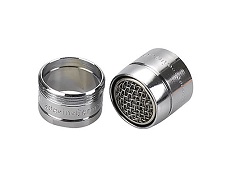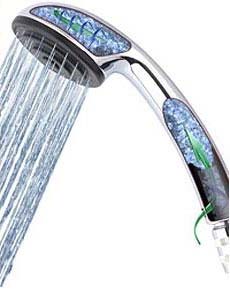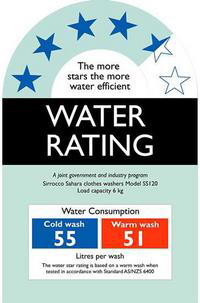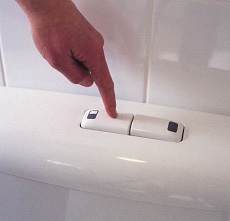11.1.1 Technical options for minimising drinking water use
Publicity campaigns to encourage people to use water sparingly are undertaken by water utilities. Flyers are distributed to customers, and radio and television are used to disseminate the message of water conservation. In Tigray, the motto is ‘Value every drop of water!’ Ways of using less water are constantly being found and Table 11.1 lists some that apply to the home.
| Advice | Notes |
| Fix leaking taps by replacing the washers. | A dripping trap can waste about 13 litres of water a day. |
| Never let the water run while brushing teeth, face washing, shaving, etc. | Leaving the tap running can waste up to 9 litres of water a minute. |
Install aerator nozzles on taps (Figure 11.1).  Figure 11.1 An aerator nozzle for a tap. | These draw air into the water flow and reduce water consumption by 10–20%. |
Install aerated showerheads (Figure 11.2).  Figure 11.2 A water-saving aerated shower-head. | These pull air into the water flow and discharge 8 litres of water a minute (because the air replaces some of the water), compared to 12 litres a minute in a standard showerhead. |
Use water-economical washing machines and use them only with a full load.  Figure 11.3 Label indicating water use by the appliance. | Labels indicate the water usage efficiency of washing machines (Figure 11.3). |
Install water-efficient dual-flush toilet cisterns where possible.  Figure 11.4 The buttons on a dual-flush toilet cistern. | Dual-flush cisterns have two buttons (Figure 11.4). If there is faecal matter to be flushed away, the right-hand button is pressed; this will use 6 litres of water to take away the faecal matter. If urine only is to be disposed of, the left-hand button is pressed; this uses 4 litres of water to take the waste away. |
| In older toilet cisterns, put one or two 1-litre plastic bottles filled with sand inside. | This reduces the flush volume by displacing the volume of bottles from the cistern, thereby reducing its effective capacity. |
| Use rainwater for toilet flushing, and for watering plants. | Rainwater can be collected from the roof, filtered and stored in a tank. |
| Use greywater (used water from showers and sinks that is not faecally contaminated) for toilet flushing or watering the garden. | The water should be filtered and disinfected before use. |
| Water garden plants and vegetable plots early in the morning or late in the evening. | This reduces the amount of water lost through evaporation. |
Many water-saving measures are simple and inexpensive to carry out (for example, fixing a leaking tap). Others (such as buying and fitting an aerated showerhead) cost money, but the savings made by using less water make these worthwhile.
11.1 Why do we need to use water efficiently?
